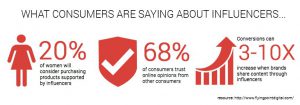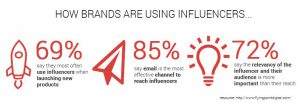A Beginner’s Guide
We all live during the times when Twitter and Facebook users give rise to social movements with million followers within a few hours. Social media users influence which candidates become presidents.
In the world of eCommerce, this way of creating and sharing ideas is called Influencer Marketing. Done right, influencer marketing can become the most effective advertising channel that generates trackable sales, so let’s review available best practices to help your eCommerce store get the best out of your (always) limited ad budget!
Why Use Influencer Marketing
Let’s define what influencer marketing is in the context of eCommerce and how it’s different from other forms of advertising. Traditional advertising is dying as consumers no longer want to be “marketed to” by a faceless brand and instead rely on internet “research” by reading blogs and social accounts of people whom they find trustworthy.

This is why we can think of influencer marketing as something similar to product placement within blockbusters: paid ads as a seamless (yet not distracting) part of a compelling story. Influencer marketing is respectful of the influencer and their audience while delivering sales – and maybe more importantly – without annoying those who are not the target audience for your eCommerce website’s products.
As an online business professional you simply cannot afford to overlook influencer marketing as a trusted, new sales generation channel that generates unique third party content linked to your eCommerce store. And the catch? Doing your homework: aligning your products with the right influences takes more time and creativity than your good ole’ context ads.
Picking the Right Influencers
Of course influencer marketing is also about the platforms like Pinterest, Instagram, Facebook, Twitter and so on – but the key part are still the influencers. These lifestyle experts are also platform experts, so whether your eCommerce site covers apparel, health, travel, fitness, whatever – you are guaranteed to find more than a few individuals who cover your product areas with some authority on a long-term basis.
We recommend shortlisting the influencers first, using platforms as additional cutoff criteria afterwards. No need to take away robot jobs here: just use online tools like Whalar, BlogDash, GroupHigh and Buzz Stream to generate a list of potential influencer marketing candidates.

Second, evaluate how, ahem, influential these influencers are – the KPI here is engagement (likes and comments). As a bonus you can see which influencers are working for your competitors by benchmarking their posts’ frequency and performance on the accounts of your more technologically savvy industry peers.
The third part is the hardest, as an effective influencer for your eCommerce store will seamlessly connect your products with stories that resonate with your target audience. Some of the dimensions to consider here are:
- Demographics: think of your ideal customer, and try to picture whether they will find advice from this guy or girl in that age category, geography, etc. trustworthy.
- Personality: does your eCommerce product need an activist, a critic or just someone who enjoys broadcasting their adventure-filled lifestyle to fit with your campaign mood? Ideally, the brand, the customer aspirations and the influencer motivation should resonate.
- Genre: or theme of interest can be one or several and can include business, technology, fashion, travel, and so on. Decide if you want broad appeal to several categories or a razor-sharp focus (the latter limiting your influencer choices, but offering niche appeal).
- Conversation Style: is defined by post format (140 characters or longform articles) and frequency. Think of all the collateral you will receive and how the photos, posts, reviews, etc. will fit into your overall marketing strategy.
There are endless considerations to chose from, but since picking influencer candidates is still more of an art than science, focus on a 2-3 key characteristics important to you to get the shortlist that will seem more like brand ambassadors than influencer marketers. To simplify, these are the people you should want to be friends with!
Creating Influencer Marketing-Powered Campaigns
Once you have created the influencer marketer shortlist based on criteria that fit your online business and your idea of campaign reach out to them! Keep in mind that the online blogger / influencer tools, just like any freelancer marketplace, usually charge about 5% of the campaign budget. If you do decide to go ahead with a campaign you will also get trackability and statistics that are not usually available when you contact influencer marketers directly.
Before agreeing on launching the campaign make sure to finalize the collaboration structure and put the following in writing:
- Timeframe and Deliverables Schedule: how much preparation time the campaign will take, outlining all deliverables and their posting schedules.
- Approval Process: you will need to review all the pieces of content to be published on the influencer’s account with a mention of your store’s products, after you review and approve them.
- Copyrights: be upfront about content usage rights. The influencer will most likely want to keep ownership rights as the creator, but you should have a multi-year content usage rights.
- Influencer Compensation: covers several related services: content creation, usage rights, and access to influencer audience. Most of the times influencers will also need a free sample of the product or a refund of an actual purchase from your eCommerce website.
- Campaign ID: this can be a variation on “sponsored content”, or a hashtag #ad for Twitter and other networks that use them. Creating an additional, unique hashtag will help you identify campaign performance.
Influencer Marketing Channels
Every social network, online community or a marketplace with a well-developed customer reviews system is a potential marketing channel for an influencer. This also means that your existing customers are already your potential influencers! Aside from Facebook Ads, some examples of influencer marketing can be:Blogs with Sponsored Product Reviews
Themed blogs that get tens and hundreds of thousands of visitors a month can be a great fit for product endorsements, including customer service endorsements that are so relevant to eCommerce stores. An advantage of engaging with influential bloggers who already have a strong relationship with readers who trust them is the kind of brand awareness that drives product sales. This method works especially well when several different blogs have positive product or service reviews.Targeted Product Placement on Instagram
It isn’t uncommon that some Instagram users have thousands of followers. For visually appealing products, this platform that thrives on images is best when posts from several popular Instagrammers simultaneously use an identical hashtag, flooding Instagram feeds.Co-Created Collections on Pinterest
For special brand and designer collaboration projects, curated boards can create buzz for well-known, staple brands. Teaming up with influential pinners is a more accessible alternative for eCommerce products that can be photographed in a creative way.Vine Product Ads
For store owners whose products solve everyday frustrations, videos produced by partnering with Vine power users can generate real viral potential. Several million views for the popular 6-second spots are not uncommon.YouTube Tutorials
Video tutorials are nothing new, but hiring a YouTube star to show their viewers how she used your eCommerce website and showing how easily anyone could do the same is a different story. Companies willing to take risks of relying on outside creativity can reach massive, new audience and drove significant revenue with unexpected partnerships.
Generally, for all channel content you should always consider repurposing all and any influencer content for advertising via display, retargeting and social networks, as third-party content will generate greater conversion rates compared to standard ads.
Tracking Influencer Marketing-Powered Sales
Marketing campaigns that cannot be tracked to sales are not great candidates for scaling. This is why tracking analytics strategy and tricks should always be a part of the discussion before an influencer marketing campaign is launched.
While not all sales cycles are direct and can be tracked, try to use any unique identifier you can! Some of the tools available are:
- Comment to Buy: an ideal tool for Instagram influencers – users can ask their followers to comment with their email address to buy the product featured. This erases the follower’s email in the comments section, but allows to automatically send an email to the follower with the direct link to buy the product.
- Tracking Pixels: great for blog influencer marketing, as website cookies track all blog readers, allowing to run cheap and effective retargeting ad campaigns and track which readers end up purchasing. Tracking pixels allow to track readers when they purchase later and do not use a direct link listed in the article.
- X-Hour Window: when paying for influencer marketing posts on fast-moving social networks like Pinterest and Instagram we recommend tracking sales within three-to-eight hour period from the time the post going live. Closely monitor your eCommerce store’s traffic and conversions and compare it to pre-influencer metrics on a similar day.
- Retargeting: anyone who looked at your product can be most easily (and cheaply) reached with ad retargeting. When engaging independent bloggers for influencer marketing always coordinate a tracking pixel – retargeting ads strategy, as conversions for sponsored content are much better with ads featuring influencer-created images.
Influencer Marketing Takeaways
To summarize, influencer marketing is the equivalent of celebrity endorsement, adopted for the world of social networks. It is an eCommerce sales channel that requires some getting used to and is most effective when used as part of several marketing campaign activities, but the efforts are often worth the results!
Did we succeed in convincing you that influencer marketing is currently the most promising form of advertising? If so, consider working with us on updating your Magento eCommerce website to include all of your store’s social #mentions!
Nice roundup of what it takes to run and influencer marketing campaign. We are seeing that people still like to do business with other people and the way to a mass market of personal relationships is to engage and promote the natural leaders. Influencer marketing is good marketing.
You are absolutely right Warren. Today more and more people are discovering the art of personal branding. When you have a personal brand, when you have an audience and people see you as a thought leader in your specific niche or market, you have something no one else does: you have people’s attention.
Awesome blog you have here but I was curious if you knew of any message boards that cover the same topics
discussed here? I’d really like to be a part of online community where I can get
feed-back from other experienced people that share the same interest.
If you have any suggestions, please let me know.
Bless you!
Hi! Thanks for the feedback.
I believe things like Reddit or Quora might be for you.